|
|
|
Sort Order |
|
|
|
Items / Page
|
|
|
|
|
|
|
| Srl | Item |
| 1 |
ID:
178840
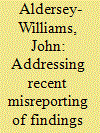

|
|
|
|
|
| Summary/Abstract |
Recent interest in the Levelised Cost of Energy (LCOE) for offshore wind has led to considerable media coverage of this topic. The paper to which this article refers provides some useful insights, but the authors are concerned that their findings are being misreported and misinterpreted. Specifically, some of the media coverage appears to misunderstand or disregard the acknowledged limitations of the paper, citing it to support contentions regarding the likely trajectory of costs for offshore wind farms. This research note addresses some of these issues and urges caution in use of the original paper’s findings. This new research note recapitulates the main themes of the original paper and directly addresses the areas where its findings have apparently been misunderstood. It concludes with a restated and reinforced warning that the analysis and projection of historic costs in offshore wind, or indeed in any fast-developing technology sector, should be undertaken with extreme caution when used to consider future cost trends.
|
|
|
|
|
|
|
|
|
|
|
|
|
|
|
|
| 2 |
ID:
121316
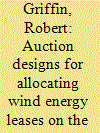

|
|
|
|
|
| Publication |
2013.
|
| Summary/Abstract |
The anticipated expansion of offshore wind energy in the U.S. has been the subject of considerable legislative effort. The Energy Policy Act (EPAct) of 2005 and the Outer Continental Shelf Lands Act (OSCLA) detail the criteria the federal government must follow when allocating leases for offshore wind farms. The Bureau of Ocean Energy Management (BOEM) provides primary federal oversight to offshore wind in federal waters, and in 2009 they released their formal management guidelines going forward. This research examines lease allocation methods BOEM may use, as well as several promising alternatives, through the lens of the mandated criteria set forth by OSCLA and the EPAct of 2005. We find significant variation between allocation methods in terms of how well they meet each of the criteria. Price-based allocations will have difficulty in meeting criteria while also accounting for the immature status of the offshore wind energy industry. Instead, a multiple factor approach which includes non-monetary considerations may be a more appropriate way to balance federal mandates and industryneeds.
|
|
|
|
|
|
|
|
|
|
|
|
|
|
|
|
| 3 |
ID:
166403
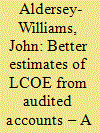

|
|
|
|
|
| Summary/Abstract |
Around the world, government policies to support new renewable energy technologies rely on accurate estimates of Levelised Cost of Energy (LCOE). This paper reveals that such estimates are based on “public domain” data which may be unreliable. A new approach and methodology has been developed which uses United Kingdom (UK) “audited” data, published in company accounts, that has been obtained from Companies House, to determine more accurate LCOE estimates. The methodology is applicable to projects configured within Special Purpose Vehicle (SPV) companies. The methodology is then applied to a number of UK offshore wind farms and one Combined Cycle Gas Turbine (CCGT) project to develop new cost data which is then compared to that presently in the public domain. The analysis reveals that recent offshore wind projects show a slightly declining LCOE and that public domain cost estimates are unreliable. But of most concern is that offshore wind farm costs are still much higher than those implied by recent bids for UK government financial support via Contracts for Difference (CfDs). The paper concludes by addressing further the question of how offshore wind projects can achieve the degree of LCOE reductions required by recent CfD bids.
|
|
|
|
|
|
|
|
|
|
|
|
|
|
|
|
| 4 |
ID:
166557
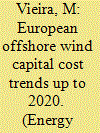

|
|
|
|
|
| Summary/Abstract |
Offshore wind capacity has increased significantly over the past decade with 16 GW installed by the end of 2017. Offshore wind technologies present an effective tool for EU countries to address their renewable production targets, as extensive areas of high winds are available offshore. However, offshore wind is not yet cost competitive in European electricity markets, and frequently requires support schemes to finance extensive capital cost requirements. Therefore, capital cost reductions are critical to make offshore wind technologies competitive in the market. Here, a benchmark tool to analyze capital expenditure trends associated with offshore wind implementation in Europe up to 2020 is provided. A database of all existing farms was developed, detailing more than 21 GW of already commissioned or consented capacity, and trends were described using multiple linear regression models. Results indicate that following a consistent rise from 2000 to 2015, capital costs have since begun to decline. The impact of several farm parameters such as turbine capacity, average farm depth or farm location on the capital expenditures have been estimated.
|
|
|
|
|
|
|
|
|
|
|
|
|
|
|
|
| 5 |
ID:
133177


|
|
|
|
|
| Publication |
2014.
|
| Summary/Abstract |
The increasing demand for renewable energy drives the development of offshore wind energy (OWE) leading to competing claims with other human and nature related uses of the North Sea. This paper investigates possibilities to identify space for new OWE while minimising effects on other uses. An inventory is made of the major uses in the Central and Southern North Sea, including the expected development towards 2030. The spatial distribution of non-wind uses is determined as well as the possibilities for differentiation based on density, economic value or nature value and co-existence. These possibilities are translated into calculation rules quantifying the relative importance. These calculation rules have been incorporated in a Decision Support System (DSS) to analyse how the priority of OWE development could impact non-wind uses. In a low OWE priority scenario consequences for other use was found to be very limited, with fisheries and wildlife affected most. In a high OWE priority scenario a considerable amount of OWE may be developed with substantial claims on sand extraction and military use areas and a shift towards higher value categories for shipping and fisheries. Relocation and co-existence of uses are important means to reduce the impact of increased OWE development.
|
|
|
|
|
|
|
|
|
|
|
|
|
|
|
|
| 6 |
ID:
103451
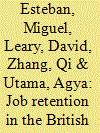

|
|
|
|
|
| Publication |
2011.
|
| Summary/Abstract |
For the case of the UK there are currently three ways of obtaining energy from sea areas, namely from wind, tides and waves. A methodology was developed to determine the future size of the offshore renewable industry based on the concept of employment factor, or the number of people required to maintain each unit of electricity production. An assessment was made of the decline in the number of people employed in oil related jobs in the North Sea and the gap that this could create in the UK's economy unless this pool of offshore expertise could find an alternative employment in the renewable sector. The paper will also investigate the effect of gradually transforming the UK's oil and gas sector into offshore renewables. If this was to happen by 2050 the UK offshore renewable industry could produce between 127 and 146 TWh of electricity, equivalent to around 57-66% of the current energy consumption in the country.
|
|
|
|
|
|
|
|
|
|
|
|
|
|
|
|
| 7 |
ID:
110731
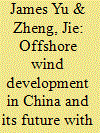

|
|
|
|
|
| Publication |
2011.
|
| Summary/Abstract |
Based on independent studies, this paper focuses on the significant discrepancy of 15 GW between the installed onshore wind generation capacity and what has been actually connected to the power network to reveal the challenges in meeting the Chinese renewable energy target. The recent accidents in Chinese North-Western transmission network (in February-April, 2011) demonstrated the urgent need for a fundamental review of the Chinese renewable energy policy. Offshore wind has been identified as the most feasible alternative to onshore wind to help deliver electricity to Eastern China during the summer peak time. By investigating and summarizing first hand experiences of participation in the Chinese renewable market, the authors provide the economic figures of the first cohort of Chinese offshore wind schemes. Large state owned enterprises (SOE) are dominating the offshore wind development, repeating their previous practices on the land. While this paper acknowledges the critical role of offshore wind generation in meeting Chinese renewable energy targets, it envisages an installed offshore capacity of approximately 2000 MW by 2015, much less than the 10000 MW governmental estimation, which can be attributed to the lack of detailed energy policy, network constraints, offshore wind installation difficulties and quality issues in the manufacture of turbines.
|
|
|
|
|
|
|
|
|
|
|
|
|
|
|
|
| 8 |
ID:
192757
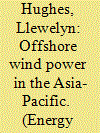

|
|
|
|
|
| Summary/Abstract |
Offshore wind power is an important technology option for decarbonising the electricity sector. An emerging region for the deployment of offshore wind is the Asia-Pacific. We conduct an expert elicitation of future cost expectations for offshore wind in the Asia-Pacific region, covering fixed-bottom and floating offshore wind technologies. We also examine views on policies that support the more rapid cost reductions for fixed bottom and floating offshore wind. We find expectations of decreases in the average levelized cost of electricity (LCOE) to USD72/MWh in 2040 (fixed-bottom) and USD81/MWh in 2050 (floating). The largest factors contributing to falling technology costs are identified as installation costs and capital costs for turbines and foundations, along with increased capacity factors. The creation of policy targets along with improved regulatory streamlining are identified as important policy measures that governments could implement to support technology cost reductions. We also find that preferred policy mixes depend on the level of technological maturity. Competitive tendering processes are identified as important for both technologies, but floating offshore wind auctions should be introduced after technology costs have fallen. In the near term, other policies are identified as more important for floating offshore technologies.
|
|
|
|
|
|
|
|
|
|
|
|
|
|
|
|
| 9 |
ID:
092612


|
|
|
|
|
| Publication |
2009.
|
| Summary/Abstract |
The first offshore wind farm became operational in 1991 in Vindeby, Denmark. By 2008, large offshore wind farms had been built in Denmark, the UK, the Netherlands, Ireland, and Sweden with a total capacity of 1200 MW. Offshore wind farms have the potential to generate a significant fraction of US electrical consumption, but the US currently lacks offshore wind farms and is still developing a regulatory system. At the state level only Texas has a leasing system for offshore wind. Since all offshore land is the property of the state and cannot be legally developed without a lease from the government, these absences have stalled development. We review and compare regulatory and leasing systems developed in Europe and the US to inform a discussion of the major issues associated with the development of an offshore leasing and regulatory system. We focus on the tradeoffs between encouraging a sustainable energy source and ensuring environmental protection and public compensation. We conclude that there are likely multiple effective methods of regulation.
|
|
|
|
|
|
|
|
|
|
|
|
|
|
|
|
| 10 |
ID:
192726
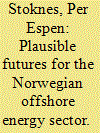

|
|
|
|
|
| Summary/Abstract |
The global energy transition from fossil to low-carbon energy challenges the future of the Norwegian petroleum sector, a major factor in the country's economy, now facing financial climate risk and long-term declining demand, particularly for gas to the EU. What energy policies can assist transition into a low-carbon society? We explore three investment scenarios for the Norwegian offshore energy sector from 2020 to 2070: 1) Business as usual, 2) Increasing cash-flow by harvesting existing petroleum fields and cutting investments (Harvest-and-Exit), or 3) Rebuilding with green offshore energy investments. In a new economic model, we compare impacts on key macro- and sector-economic variables. We find that rebuilding by investing moderately in green offshore energy production could reverse the extra job decline that a quicker phase-out of petroleum investments would incur. The impacts on the Norwegian sovereign wealth fund - Government Pension Fund Global - and on gross domestic product (GDP) per capita are insignificant to 2050 and positive by 2070. The simulated investments and economic results can be compared with observations to constitute forward-looking indicators for energy transitioning in producer countries.
|
|
|
|
|
|
|
|
|
|
|
|
|
|
|
|
| 11 |
ID:
150345


|
|
|
|
|
| Summary/Abstract |
We analyse the joint problem of supporting renewables and resource adequacy in a liberalised electricity market and present a detailed model-based comparison of two alternative policies. We undertake this in the context of the British market. We show how, ceteris paribus, the progressive replacement of coal with wind imposes extra costs of reserve and evaluate alternative way to meet this, whether through capacity payments funded by customers, or a reliability requirement on wind generators with capital cost or energy feed-in subsidies. We consider the reality of market concentration and the extent to which pragmatic regulation could allow prices to rise above marginal cost to reduce the extent of direct subsidies and complex market designs. We also evaluate the implied cost of carbon reduction in a progressive replacement of coal with wind, when the security is maintained by extra peaking gas. We find that support through capital allowances rather than the energy market is more efficient.
|
|
|
|
|
|
|
|
|
|
|
|
|
|
|
|
| 12 |
ID:
180180


|
|
|
|
|
| Summary/Abstract |
The Atlantic Coast of the United States represents one of the most promising development environments for offshore wind installation in the world due to the convergence of several geographic factors. These include, but are not limited to, population size and density, electricity prices, ocean depth, wind speed, and the dynamics of the region's current energy infrastructures. However, these have not been sufficient to kickstart a mass movement to offshore energy generation despite two decades of affirmative discussions and some entrepreneurial starts. Planned projects now total over 6 GW. Presently, market variables and institutional controls have become more hospitable for development though undertested except in small pilot projects. Socio-cultural concerns including interaction with the fishers, coastal tourism and real estate, Native American Tribes, and environmental and aesthetic factors have been studied, but applicable information remains limited to reliance on comparisons with European offshore wind research, hypothetical analyses, and attention to small pilot projects. This gap as well as a fundamentally differentiated patchwork of state and local stages means that the current research direction will need to be extended through the development of the first utility-scale projects with attention to new case studies as well as new perspectives, framings, and questions. This report outlines important physical and social policy factors of offshore wind development and then explores several case studies.
|
|
|
|
|
|
|
|
|
|
|
|
|
|
|
|
| 13 |
ID:
103594
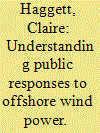

|
|
|
|
|
| Publication |
2011.
|
| Summary/Abstract |
This paper is about understanding the role and importance of public responses to offshore wind power. It builds on a framework for understanding social acceptance and opposition to onshore turbines, and reviews the emerging research on offshore wind. While less is known about how people will respond to offshore than onshore wind, there is now an emerging body of research. From this literature, several common factors which influence responses have emerged and are discussed here: the (continued) role of visual impact; place attachment to the local area; lack of tangible benefits; relationships with developers and outsiders; and the role of the planning and decision-making systems. The paper argues that, as with onshore developments, the public should be included in decision-making about offshore wind farms, and that they have a key role which should not be underestimated. The paper concludes with some thoughts about the means to involve people and how effected communities might be effectively acknowledged, identified and engaged.
|
|
|
|
|
|
|
|
|
|
|
|
|
|
|
|
| 14 |
ID:
150401


|
|
|
|
|
| Summary/Abstract |
This paper aims to provide insights in the cost developments of offshore wind energy in Europe. This is done by analysing 46 operational offshore wind farms commissioned after 2000. An increase of the Capital Expenditures (CAPEX) is found that is linked to the distance to shore and depth of more recent wind farms and commodity prices. Analysis results indicate that these two factors are only responsible for about half of the observed CAPEX increase, suggesting other factors such as turbine market with limited competition also led to an increasing CAPEX. Using CAPEX, Annual Energy Production, Financings costs and Operational Expenditures, the development of average Levelized Cost of Electricity (LCoE) is shown to increase from 120 €/MWh in 2000 towards 190 €/MWh in 2014, which is a direct result of the CAPEX increase. The results indicate very different LCoE values among European countries, from currently about 100 Euro/MWh in Denmark and Sweden to 150-220 Euro/MWh in all other countries investigated suggesting an effect of national policy frameworks on the LCoE of offshore wind energy.
|
|
|
|
|
|
|
|
|
|
|
|
|
|
|
|
|
|
|
|
|